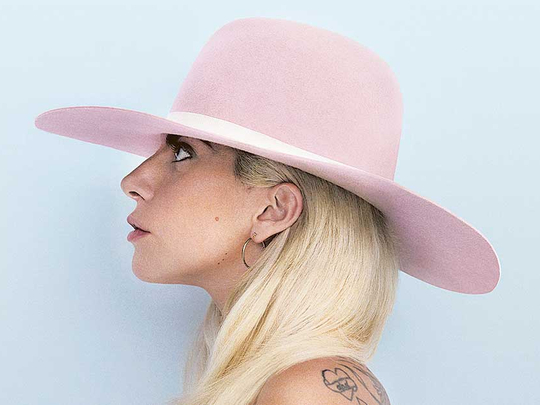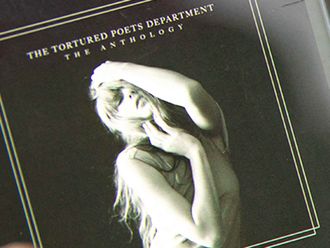
Here’s a weird name to throw in the mix for next year’s Desert Trip: Lady Gaga.
A deep believer in the power of costume and character and thumping electronic beats, this 30-year-old pop star hasn’t historically sold herself to the classic-rock lovers that assembled this month near Palm Springs to witness Neil Young flay his guitar in a black T-shirt and jeans.
But on her new album, Joanne, Gaga is speaking precisely their language. Released on October 21, it rolls out one boomer signifier after another, beginning with the slinky Stevie Nicks homage of the opening cut, Diamond Heart, and proceeding through songs that emulate Elton John, Bruce Springsteen and the Rolling Stones, the latter another Desert Trip performer.
In the title track she even steps to Simon and Garfunkel’s fingerpicked folk — with Paul Simon’s son Harper on guitar.
The narrative already taking shape around Joanne is that the album represents a course correction after the perceived excess of Gaga’s previous solo album, 2013’s Artpop. She’s going back to her roots, this thinking goes, in order to find something real and true.
But what do roots mean for Lady Gaga?
Born in New York, she grew up a theatre kid and found early success with a club track called Just Dance. So the idea that she’s returning to the wellspring, or shunning her love of artifice, is absurd.
For Gaga, classic rocker is just another pose — as, indeed, were the jazz singer she portrayed on Cheek to Cheek, her 2014 album with Tony Bennett, and the Broadway belter she became in her tribute to The Sound of Music at last year’s Academy Awards.
Which is fine — dress-up is fun, after all, and sometimes more revealing than stripping down. And don’t let the T-shirt fool you: Gaga is definitely dressing up here, no less than when she notoriously donned that gown made of meat.
In a way, Joanne is her most theatrical effort yet, with an expansive cast of players that includes Mark Ronson, Beck, Father John Misty and dudes from detail-obsessed rock bands like Queens of the Stone Age and Tame Impala. (Este Haim, one of the sisters in LA’s Haim, even shows up playing percussion on one song.)
Working together, they assemble some gorgeous pieces. There’s Come to Mama, for instance, which re-creates Springsteen’s squealing soul-rock circa Born to Run. There’s Hey Girl, a duet with Florence Welch that imagines Bennie and the Jets as an ‘80s R’n’B jam. And there’s Perfect Illusion, the album’s ecstatic yet paranoid lead single, which reminds me of jittery disco-rock songs like Billy Joel’s Pressure or Shattered by the Stones.
Joanne — whose title comes, rather tellingly, from an aunt who died before Gaga could meet her — also has harder-to-classify tunes such as Sinner’s Prayer, a sort of spaghetti-western fantasia with Sean Lennon on slide guitar, and John Wayne, which mashes up tinny Euro-house synths, slowed-down funk drums and a boot-scooting bass line straight out of Nashville.
Gaga pulls from country music in A-Yo, a digital honky-tonk rave-up, and the acoustic ballad Million Reasons, both of which the singer co-wrote with Hillary Lindsey (of Little Big Town’s Girl Crush fame).
But here again the notion of roots music as a crucible for authenticity seems silly; Gaga’s singing in the masterfully composed Million Reasons — “Lord show me the way to cut through all this worn-out leather,” goes one brilliant line — is pure performance, a careful choreography of gulps and swoops.
If she’s acting as usual, then what’s the message of the play? In the past Gaga has employed her characterisations to illustrate the plight of the marginalised, and there’s some of that on Joanne, in Diamond Heart, about a go-go dancer whose innocence is “wrecked,” and the lugubrious Angel Down, which the singer has said was inspired by the killing of Trayvon Martin.
Come to Mama delivers a sermon of tolerance that has its heart (if not its brain) in the right place: “The only prisons that exist are ones we put each other in,” she sings, not unlike a fourth-grader. Hey Girl fares better as a conversation between two women promising to walk each other home because they can’t find a cab.
Yet other songs, for all their vivid sonic colour, lack strong stories. A-Yo, John Wayne and Sinner’s Prayer feel like mere stylistic exercises in a way that Gaga’s earlier stuff never did — costume dramas minus the drama, in other words.
Perhaps the singer felt that by borrowing such durable threads, she could rely on their ready-to-wear associations. And at its best, Joanne makes thrilling use of those meanings; it makes you want to see Lady Gaga find a place among the grizzled icons at Desert Trip.
But she can’t just tell us she really means it, man. She has to fool us into believing it too.













